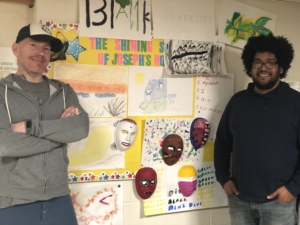Envisioning a Healthy Tomorrow: Art Therapy Helps Residents Overcome Traumatic Experiences
The following article appears in the fall 2019 issue of the Joseph’s Journey newsletter. Read the full newsletter here.

Ursuline College student Mike Boyce works with residents to create art to help overcome trauma.
For those dealing with trauma, it is often difficult to discuss or express the events that have shaped their lives. Sometimes the words just cannot be said for fear of reliving the trauma.
As part of the holistic healing process for residents, the vast majority of whom have experienced traumatic events, Joseph’s Home launched a partnership with Ursuline College to provide art therapy. Students from the Ursuline Counseling and Art Therapy Program work as part of a semester-long cohort with residents to help them cope with the trauma that may have contributed to their homelessness in the first place.
Ursuline student and native Clevelander Mike Boyce helped develop the program. Mike found a life’s mission in helping the homeless after experiencing homelessness himself when he was a young man. As a student at the California College of the Arts, Mike developed a project focused on homelessness, interviewing homeless men and women about the greatest
challenges they faced.
“Many of them said it was the way children looked at them,” Mike said.
“Then, I started talking to mothers about how they talked to their children about homelessness. They all said the same thing—that they shield them from it or cover their children’s eyes if they see someone who is homeless.”
That experience led Mike to publish a children’s book, “Who’s Homeless,” and, more recently, his second book, “Homeless,” to help create deeper understanding for those who are homeless and provide support for school children experiencing homelessness. His journey also sparked his life’s mission and brought him back to Cleveland to pursue a career in art therapy.
“When it comes to trauma and abuse, sometimes you have been told you can’t talk about it or are afraid, but you can draw it and begin to see the patterns that shape you.” — Mike Boyce
A key element of working through trauma is allowing an individual to express their own emotions and beliefs about what happened to them. Art therapy provides a safe method of expression and can often lead to a deeper understanding of one’s own experience. Studies show that art therapy frequently enables repressed memories or subconscious feelings to come forward.
After his semester was finished, Joseph’s Home brought Mike back to work one-on-one with Christian, a 22-year-old resident whose life story closely mirrored Mike’s own life. As one of their projects, Mike asked Christian to draw a picture of himself standing in the rain. Christian’s work was telling, showing him standing under half of an umbrella, surrounded by a thunderstorm, tornado and a sink hole.
“While he was working, we talked the entire time. I was able to ask him about those moments—what does the sink hole represent? Why are you standing under only half of the umbrella? By talking about the picture, it was less intimidating and allowed him to share his experiences and help him work through his trauma,” said Mike.

Mike (left) with fellow Ursuline art therapy student Josh.
Raven Kauffman, Joseph’s Home respite care manager, said art therapy also enables the men to begin to envision what their lives can become and who they want to be. Many of the projects are on display throughout Joseph’s Home to share the men’s personal stories with other residents, staff and volunteers.
“We use art therapy as a journey. It is the men’s journey into wellness, for them to see themselves sick and then how they want to see themselves healthy in the future,” Raven said. “Everyone’s story is unique, so it helps our residents see their own situations and understand themselves. More importantly, it enables them to see where they can go.”


